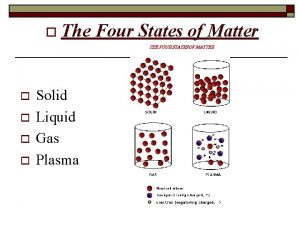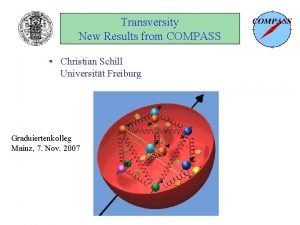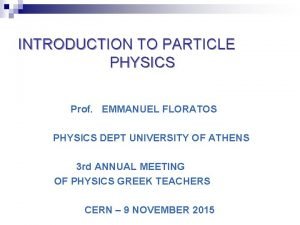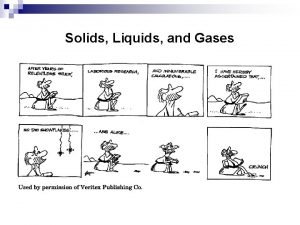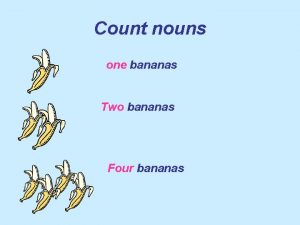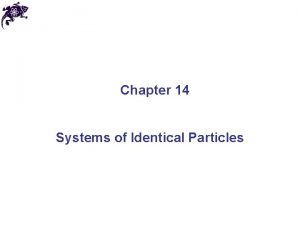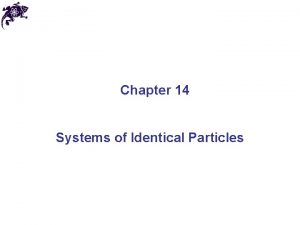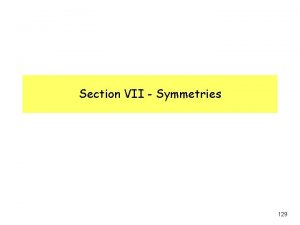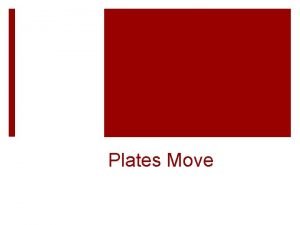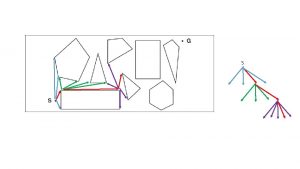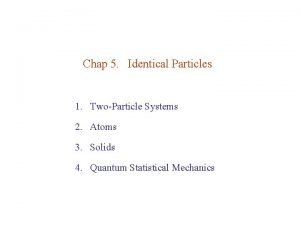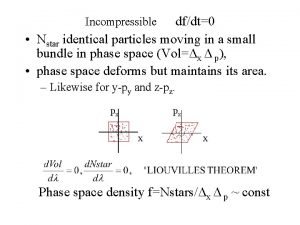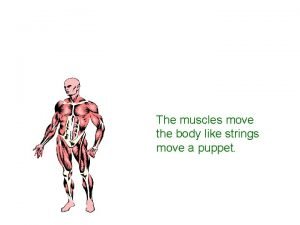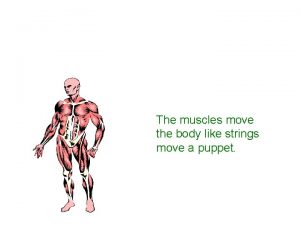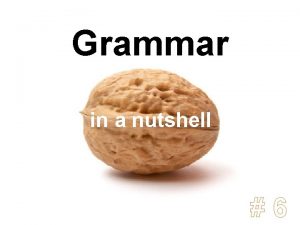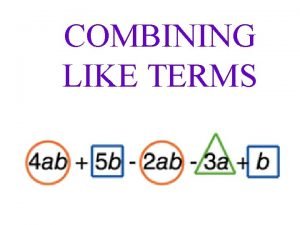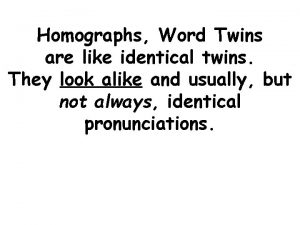Identical Particles We would like to move from
























- Slides: 24

Identical Particles ØWe would like to move from the quantum theory of hydrogen to that for the rest of the periodic table n One electron atom to multielectron atoms ØThis is complicated by the interaction of the electrons with each other and by the fact that the electrons are identical n The Schrodinger equation for the two electron atom can only be solved by using approximation methods 1

Identical Particles ØIn classical mechanics, identical particles can be identified by their positions ØIn quantum mechanics, because of the uncertainty principle, identical particles are indistinguishable n This effect is connected with the Pauli exclusion principle and is of major importance in determining the properties of atoms, nuclei, and bulk matter 2

Identical Particles 3

Identical Particles Ø An important case is when the particles do not interact with each other n n This is called the independent particle model It’s the starting point for the He atom e. g. 4

Identical Particles Ø Let’s say particle 1 is in quantum state m and particle 2 is in quantum state n Ø If we interchange the two particles then Ø We get different wave functions (and probability densities) so the two particles are distinguishable n Two particles are indistinguishable if we can exchange their labels without changing a measurable quantity n Thus neither of the solutions above is satisfactory 5

Identical Particles Ø In fact there are two ways to construct indistinguishable wave functions n n n Ψs is a symmetric wave function under particle interchange of 1↔ 2 w Ψs →Ψs Ψa is a antisymmetric wave function under particle interchange of 1↔ 2 w Ψa → -Ψa The probability density remains unchanged under particle interchange of 1↔ 2 6

Identical Particles Ø All particles with integer spin are called bosons n n Spin 0, 1, 2, … Photon, pions, Z-boson, Higgs Ø All particles with half integer spin are called fermions n n Spin 1/2, 3/2, … Electron, proton, neutron, quarks, … Ø For the next few lectures we’ll focus on the fermions (electrons) 7

Identical Particles Ø The wave function of a multi-particle system n n of identical fermions is antisymmetric under interchange of any two fermions of identical bosons is symmetric under interchange of any two bosons Ø The Pauli exclusion principle follows from these principles n No two identical electrons (fermions) can occupy the same quantum state 8

Identical Particles Ø What about 3 particles? Ø Symmetric Ø Antisymmetric n Use the Slater determinant 9

Identical Particles ØJust a reminder, we are presently only working with the space wave functions n We’ll get to spin in a little bit ØA consequence of identical particles is called exchange “forces” n n Symmetric space wave functions behave as if the particles attract one another Antisymmetric wave functions behave as if the particles repel one another 10

Infinite Square Well Ø Quick review. For an infinite well at x=0 and x=L 11

Identical Particles Ø Let’s return to the infinite well problem only now with two particles n Case 1 distinguishable particles n Case 2 identical particles (symmetric) n Case 3 identical particles (antisymmetric) 12

Identical Particles Ø What is the probability that both particles will be on the left side of the well? Ø Case 1 13

Identical Particles Ø Case 2 and 3 Ø For a symmetric wave function (+) the particles are more likely on the same side (attracted) Ø For the antisymmetric wave function (-) the particles 14 are more likely on opposite sides (repel)

Identical Particles Ø The wave function of a multi-particle system n n of identical fermions is antisymmetric under interchange of any two fermions of identical bosons is symmetric under interchange of any two bosons Ø The Pauli exclusion principle follows from these principles n No two identical electrons (fermions) can occupy the same quantum state 15

Periodic Table ØThe Pauli exclusion principle is the basis of the periodic table n n n This is why all the electron’s don’t simply fall into the ground state – because they are fermions Recall there were 4 quantum numbers that specified the complete hydrogen wave function: n, l, ml, and ms No two electrons in the same atom can have these same quantum numbers 16

Periodic Table ØBuilding the periodic table n n Principle quantum number n forms shells Orbital angular momentum quantum number l forms subshells w l=0, 1, 2, 3, … are called s, p, d, f, … n n n Each ml can hold two electrons, one spin up (ms=1/2) and one spin down (ms=-1/2) The electrons tend to occupy the lowest energy level possible Electrons obey the Pauli exclusion principle 17

Periodic Table Ø Energy levels n n n Note for multielectron atoms, states of the same n and different l are no longer degenerate This is because of screening effects Referring back to the radial probability distributions, because the s states have non-zero probability of being close to the nucleus, their Coulomb potential energy is lower 18

Ionization Potential 19

Periodic Table ØHydrogen (H) n 1 s 1 ØHelium (He) n 1 s 2 – closed shell and chemically inert ØLithium (Li) n 1 s 22 s – valence +1, low I, partially screened, chemically very active ØBeryllium (Be) n 1 s 22 s 2 – Closed subshell but the 2 s electrons can extend far from the nucleus 20

Periodic Table Ø Boron (B) n 1 s 22 p 1 – Smaller I than Be because of screening Ø Carbon (C) n n 1 s 22 p 2 – I actually increases because the electrons can spread out in 2/3 l state lobes The valence is +4 since an energetically favorable configuration is 1 s 22 s 12 p 3 Ø Nitrogen (N) n 1 s 22 p 3 – See comments for C. Electrons spread out in 3/3 l state lobes Ø Oxygen (O) n n 1 s 22 p 4 – Two of the l state electrons are “paired” Electron-electron repulsion lowers I 21

Periodic Table ØFluorine (F) n 1 s 22 p 5 – Very chemically active because it can accept an electron to become a closed shell ØNeon (Ne) n 1 s 22 p 6 – Like He 22

Periodic Table 23

Periodic Table Ø Periodic table is arranged into groups and periods Ø Groups n n Have similar shell structure hence have similar chemical and physical properties Examples are alkalis, alkali earths, halogens, inert gases Ø Periods n n n Correspond to filling d and f subshells Examples are transition metals (3 d, 4 d, 5 d), lanthanide (4 f), and actinide (5 f) series Because there are many unpaired electrons, spin is important for these elements and there are large magnetic effects 24
 Would prefer grammar
Would prefer grammar Would like would prefer would rather
Would like would prefer would rather Identical by descent vs identical by state
Identical by descent vs identical by state Identical particles
Identical particles How do particles move in a liquid
How do particles move in a liquid Particle arrangement of plasma
Particle arrangement of plasma Cloudy mixture with particles that move erratically
Cloudy mixture with particles that move erratically Solid+heat=
Solid+heat= Lateral thinking brain teasers
Lateral thinking brain teasers Christian schill
Christian schill Point like particles
Point like particles Gas like mixture of charged particles
Gas like mixture of charged particles Orcs and hobbits problem
Orcs and hobbits problem I ll look like if looking liking move
I ll look like if looking liking move Fungus like protists characteristics
Fungus like protists characteristics Romeo and juliet alliteration examples
Romeo and juliet alliteration examples Expressing preference would rather
Expressing preference would rather Past perfect conditional
Past perfect conditional Would you like some soup
Would you like some soup Do you like bananas
Do you like bananas I would like to thank my supervisor
I would like to thank my supervisor Do you like bananas yes i do
Do you like bananas yes i do Would you like some noodles
Would you like some noodles Banana plural nouns
Banana plural nouns Patrick loves bubblegum and would like
Patrick loves bubblegum and would like





